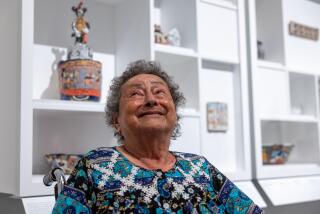Eva Zeisel dies at 105; ceramic artist and designer known for her tableware
Eva Zeisel, one of the most influential industrial designers of the 20th century who created lyrical yet practical tableware and ceramics, has died. She was 105.
Zeisel, whose deceptively simple designs first became popular in the 1940s and are still sold at major design outlets, died Friday in New York City, it was announced on her website.
“Eva Zeisel took industrial design and made it more human and sensual. She trusts that a good curve is enough,” David Reid of design studio KleinReid, which features her work, told The Times in 2005.
Few who admired her often-abstract designs knew that, during her long and adventurous life, Zeisel had been imprisoned as a young woman in the Soviet Union and was later forced to flee Nazi-occupied Austria.
In 1938, she immigrated to the United States with her husband, Hans Zeisel, and within a few years was designing a fine set of chinaware for the Museum of Modern Art in New York and Castleton China. The pieces, and Zeisel, were the focus of a MOMA exhibit in 1946.
The British Museum in London has in its collection her colorful mix-and-match “Town and Country” dinnerware first made by Red Wing Pottery in Minnesota in the 1940s. The salt and pepper shakers from that set — with their plump, anthropomorphic bodies curving toward each other — are iconic. Her vintage designs have long been collectibles.
By her own estimation, Zeisel had designed 100,000 pieces of tableware, in styles as diverse as Bauhaus, Russian Art Nouveau and her best-known approach, organic modern.
An exhibit in 2007 at the Craft and Folk Art Museum in Los Angeles, “Eva Zeisel: Extraordinary Designer at 100,” included a recent collaboration with retailer Crate & Barrel based on her curvaceous designs from the 1950s.
Many who fancied her vast array of plates, cups, vases and other objects enough to put them on the dinner table did not know her name. The designer appeared untroubled by her relative anonymity, focusing instead on “the user” who was “my good friend,” Zeisel said in 2004 in the Atlanta Journal-Constitution.
“I’m always thinking about my friend, someone to whom I’m giving my loveliness, my friendship and my shapes,” she said.
Those elegant pieces often appeared to have human qualities, particularly in the way they tended to curve and nestle. “All my work is mother-and-child,” Zeisel once said. Often critical of Modernism despite being one of its towering figures, the designer said she simply tried to recapture the “magic language of things.”
In 2005, then-98-year-old Zeisel chuckled as she told a National Public Radio interviewer that she gravitated to curves “probably because I consist myself of curves instead of straight lines, meaning I’m a little bit fat.”
Eva Amalia Striker was born Nov. 13, 1906, in Budapest, Hungary, into a prosperous Jewish family. Her father was a textile manufacturer.
She studied painting at the Royal Academy of Fine Arts in Budapest but soon turned to something she thought more practical: pottery. She apprenticed in her home city and later worked in Hamburg and Berlin.
After becoming interested in Russian art and culture, she moved to Ukraine. She quickly rose through the ranks of pottery design and production in the Soviet Union, and by age 29 was art director at the state-run Porcelain and Glass Industries.
Her life took a terrifying turn in 1936, when she was arrested on trumped-up charges that she had plotted to assassinate Soviet dictator Josef Stalin. She was imprisoned for 16 months, spending most of it in solitary confinement. Her confinement included torture and brainwashing, and became the basis for her friend Arthur Koestler’s stark 1941 novel about totalitarianism, “Darkness at Noon.”
“You never knew when the door would open and you would be shot,” Zeisel said many years later. “So you learned to rule out the future.”
When she was released, Zeisel later said, she thought the guards were taking her to be executed. She arrived in Vienna just six months before Hitler annexed Austria and then fled to London, where she married Hans Zeisel, a lawyer she had known in Vienna. The couple arrived in the U.S. with $64.
In New York, Zeisel pored over design periodicals at the library and contacted a magazine editor, who connected her with a china factory that hired Zeisel to create a set of dishes. She did so overnight and earned $100.
She soon got other jobs, including teaching ceramics at New York City’s Pratt Institute, where she developed one of the first industrial design courses for ceramics in the United States. She later taught at the Rhode Island School of Design.
When MOMA asked her to design a set of dishes in 1942, Zeisel created what is now considered a classic — an all-white set unlike anything then being produced in this country.
“You would have expected flowers or some kind of gilt decoration or some kind of scrolled handle,” Karen Kettering, who curated a traveling Zeisel exhibit, told NPR in 2005. “Instead what you have are very simple forms and everything slightly rounded,” an effect that was “a very modern way of being formal.”
Zeisel went on to design for such major manufacturers as Hall China, Federal Glass and Noritake. She also did pieces for Sears and Roebuck.
During the 1960s, Zeisel’s aesthetic went somewhat out of favor. She all but abandoned her work, turning to writing and protesting the Vietnam War.
In the 1980s, she returned to product design when an art museum in Montreal mounted an exhibition of her work and midcentury designers in general were enjoying a comeback. Even after passing the century mark, she remained active and was continually delighted by the ubiquity of her creations.
“When I met my designs in the market of a remote village in the West Indies, or in the airport restaurant in Zurich, I felt like the mother of many well-behaved children,” she once wrote.
When asked in 2001 how she could have left behind the grimness of her imprisonment to design such beautiful objects, she told Metropolis magazine: “Well, you come out so pleased with life. Everything is unexpectedly colorful.”
She maintained a country home and workshop in Rockland County, N.Y., and also had homes in New York City and Chicago, where her husband was a prominent law and sociology professor at the University of Chicago. He died at 86 in 1992.
Zeisel was the subject of the 2002 documentary “Throwing Curves” and the 2003 biography “Eva Zeisel” by Lucie Young.
In her early 90s, Zeisel conceded that the world did not need “all these dishes.”
“They’re cold, they’re hard, and we have to wash them,” she told Newsday in 1997, then added playfully: “But paper plates will never bring a family together,” or “teach children to say, ‘May I be excused?’ Obviously, it’s a cultural need, and it’s the designer who makes them festive.”
Zeisel’s survivors include a daughter, Jean Richards; a son, John; and three grandchildren.
Luther is a former Times staff writer.
More to Read
Start your day right
Sign up for Essential California for the L.A. Times biggest news, features and recommendations in your inbox six days a week.
You may occasionally receive promotional content from the Los Angeles Times.




















































